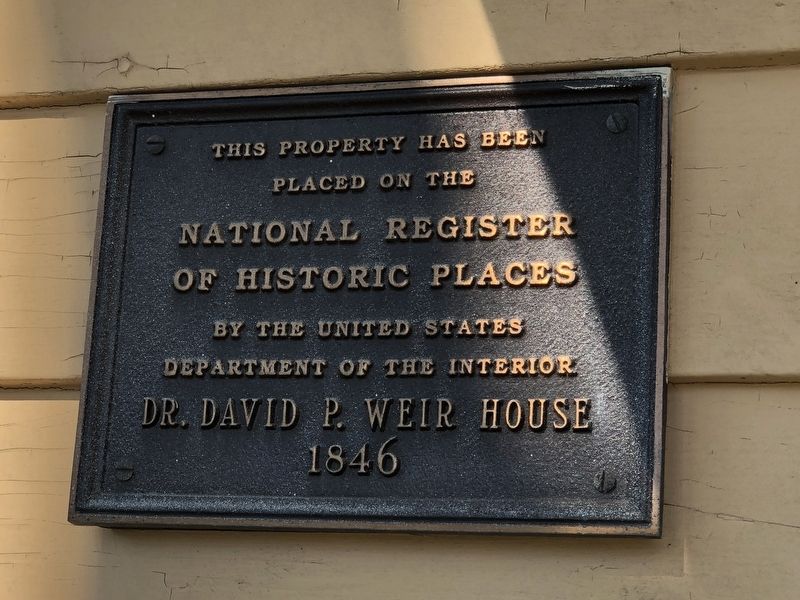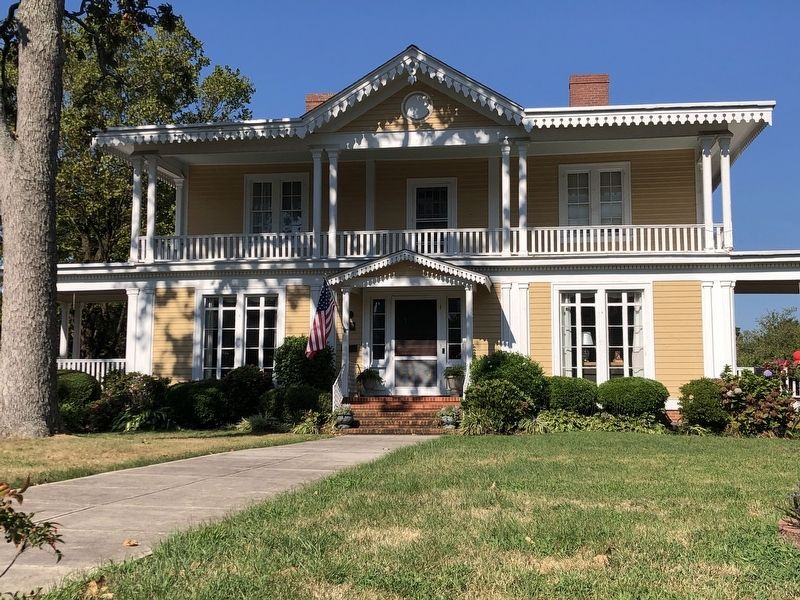Downtown in Greensboro in Guilford County, North Carolina — The American South (South Atlantic)
Dr. David P. Weir House
placed on the
National Register
of Historic Places
by the United States
Department of the Interior
Dr. David P. Weir House
1846
Topics and series. This historical marker is listed in this topic list: Architecture. In addition, it is included in the National Register of Historic Places series list. A significant historical year for this entry is 1846.
Location. 36° 4.479′ N, 79° 47.778′ W. Marker is in Greensboro, North Carolina, in Guilford County. It is in Downtown. Marker is on North Edgeworth Street north of West Friendly Avenue, on the left when traveling north. Touch for map. Marker is at or near this postal address: 223 N Edgeworth St, Greensboro NC 27401, United States of America. Touch for directions.
Other nearby markers. At least 8 other markers are within walking distance of this marker. O. Henry (about 700 feet away, measured in a direct line); Edgeworth Female Seminary (approx. 0.2 miles away); Gertrude Weil (approx. ¼ mile away); West Market Street United Methodist Church (approx. ¼ mile away); Lucy Robertson (approx. ¼ mile away); In Memory of M/Sgt. Edwin V. Bain (approx. ¼ mile away); Greensboro College (approx. ¼ mile away); a different marker also named Gertrude Weil (approx. ¼ mile away). Touch for a list and map of all markers in Greensboro.
Regarding Dr. David P. Weir House. Excerpt from the National Register nomination:
The Dr. David P. Weir House, one of ten surviving antebellum structures in Greensboro, displays notable ornamental details that distinguish it from the majority of houses that survive from the period in the city and in surrounding Guilford County. The house may have been built from a plan provided by the well-known New York architect Alexander Jackson Davis, who had designed Blandwood, the Greensboro home of governor John Motley Morehead, in 1844. Davis recorded in his daybook that he provided Weir with a plan during a visit to Greensboro during that year, but it is not known whether Weir eventually used it or how much it was modified in execution. The house does not resemble any of Davis' known works, and has a double-pile, center-hall plan similar to other substantial antebellum houses of the North Carolina piedmont. However, the house displays several decorative features unusual for the piedmont at the time, notably the sawn ornament suggestive of pattern book Gothic cottage character. If the house's design was based on Davis' plan, it is the only surviving house in Guilford County other than Blandwood which is associated with this nationally prominent architect. Whatever the origins of its architectural character, the house is significant because of its connection with Dr. David P. Weir (ca. 1815-1865), a native of Ireland, who established a medical practice in Greensboro by 1840 and served as an official of Edgeworth Female Seminary, a well-known finishing school for girls established by Governor Morehead. In 1851 he helped found the Greensboro Life Insurance and Trust Company. Weir served as the chief operating officer of the firms, which prospered as one of antebellum Greensboro's three banking houses, from 1853 until his death. James F. Jordan, a prominent Greensboro tobacconist, purchased the house from the estate of Weir's widow in 1890. Jordan was reputedly responsible for attracting wealthy northern businessmen such as J. P. Morgan, Henry Frick, and Pierre Lorillard to Guilford County for hunting, and several of these men erected hunting lodges in the county. The Greensboro's Woman's Club bought the house in 1921 and has used the residence as its clubhouse since that time.
Also see . . .
1. Dr. David P. Weir House (PDF). National Register nomination for the house, which was listed in 1984. (Prepared by Peter R. Kaplan and Marshall Bullock, N.C. Division of Archives and History; via National Archives) (Submitted on October 17, 2023, by Duane and Tracy Marsteller of Murfreesboro, Tennessee.)
2. Radiant Bride. The Weir-Jordan house is firmly wedded to Greensboro’s past. (Billy Ingram, O.Henry Magazine, November 2017) (Submitted on October 17, 2023, by Duane and Tracy Marsteller of Murfreesboro, Tennessee.)
Credits. This page was last revised on October 17, 2023. It was originally submitted on October 6, 2023, by Duane and Tracy Marsteller of Murfreesboro, Tennessee. This page has been viewed 63 times since then and 16 times this year. Photos: 1, 2. submitted on October 6, 2023, by Duane and Tracy Marsteller of Murfreesboro, Tennessee.

